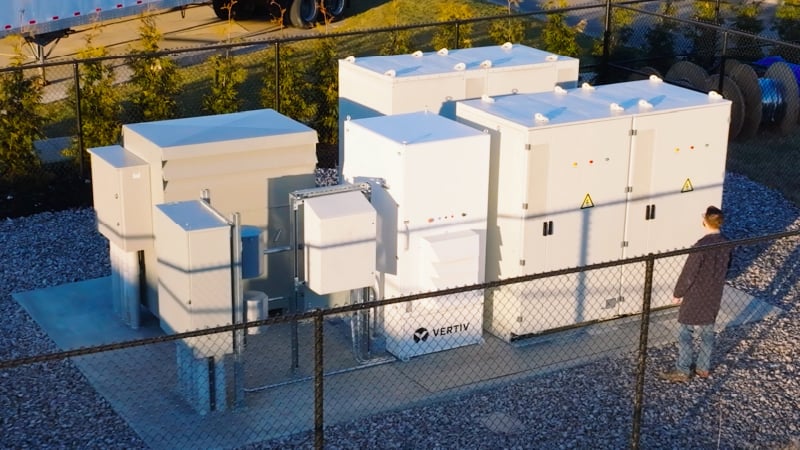Are sand batteries the future of clean energy storage? – Interesting Engineering

Report on Sand-Based Thermal Energy Storage and its Contribution to Sustainable Development Goals
This report analyzes the emergence of sand-based thermal energy storage systems, commonly known as sand batteries, as a viable technology for grid-scale and industrial heating applications. It evaluates the technology’s operational principles, current deployments, and future potential, with a significant emphasis on its alignment with the United Nations Sustainable Development Goals (SDGs).
Technological Framework and Operational Principles
Sand batteries represent a critical innovation in long-duration energy storage, addressing the challenge of intermittency associated with renewable energy sources like wind and solar. The technology is designed to store surplus energy as heat, contributing directly to SDG 7 (Affordable and Clean Energy) by enhancing the reliability and usability of renewables.
Operating Mechanism
The core function of a sand battery is to convert electrical energy into thermal energy and store it within a large, insulated silo filled with sand or a similar granular material.
- Surplus electricity from renewable sources powers a resistive heater.
- The heater warms air, which is then circulated through a closed-loop system of pipes within the sand-filled silo.
- The sand is heated to temperatures ranging from 600°C to 1,000°C (1,112°F to 1,832°F).
- Due to the high insulation of the container and the thermal properties of sand, the heat is stored with minimal loss for extended periods, from weeks to months.
- When energy is required, cool air is passed through the hot sand, and the resulting heated air is distributed for use in district heating systems or industrial processes.
Material Properties and Sustainability
The selection of sand as the storage medium is central to the technology’s sustainability and cost-effectiveness, aligning with SDG 12 (Responsible Consumption and Production).
- High Specific Heat Capacity: Sand can absorb and store significant amounts of thermal energy.
- Low Thermal Conductivity: It releases heat slowly, enabling long-duration storage with efficiency rates up to 99% for direct heating applications.
- Abundance and Low Cost: Sand is an inexpensive and widely available resource. Some systems utilize waste materials like crushed soapstone, promoting a circular economy.
- Durability and Safety: The material does not degrade over cycles, is non-toxic, non-flammable, and poses no risk of explosion, unlike some chemical batteries.
Alignment with Global Sustainable Development Goals (SDGs)
Sand battery technology offers a multi-faceted solution that advances several key SDGs, positioning it as a cornerstone for future sustainable infrastructure.
SDG 7: Affordable and Clean Energy
By capturing and storing excess energy from intermittent renewables, sand batteries ensure a stable and reliable supply of clean heat. This reduces curtailment (wastage) of wind and solar power and decreases reliance on fossil fuels for heating, making clean energy more affordable and accessible for communities and industries.
SDG 9: Industry, Innovation, and Infrastructure
This technology is a significant innovation in energy infrastructure. It provides a scalable solution for decarbonizing industrial processes, which account for over half of all energy consumed for heat. Deploying sand batteries builds resilient, sustainable infrastructure capable of supporting a global transition to a low-carbon economy.
SDG 11: Sustainable Cities and Communities
The application of sand batteries in district heating systems, as demonstrated in Finland, directly contributes to creating sustainable cities. These systems provide clean, locally sourced heating, reducing the carbon footprint of urban areas and enhancing energy security for residents.
SDG 13: Climate Action
The primary impact of sand batteries is on climate action. By enabling the large-scale replacement of fossil fuel-based heating with stored renewable energy, the technology directly mitigates greenhouse gas emissions. It is a practical and scalable tool in the global effort to combat climate change.
Real-World Deployments and Market Projections
The viability of sand batteries is being proven through commercial and research initiatives worldwide.
- Polar Night Energy (Finland): The world’s first commercial sand battery became operational in Kankaanpää in 2022. A larger system in Pornainen stores 100 MWh of thermal energy, sufficient to heat a town and support Finland’s goal of climate neutrality by 2035.
- National Renewable Energy Laboratory (NREL, USA): NREL is developing a 100-hour long-duration thermal energy storage system, demonstrating the technology’s potential for grid stabilization in the United States.
- Batsand (Latvia): This company is developing home-scale sand batteries, aiming to decentralize clean heating solutions.
The global market for sand batteries was valued at approximately USD 1.2 billion in 2024 and is projected to reach USD 4.86 billion by 2034, indicating strong confidence in its growth and adoption.
Challenges and Future Outlook
Despite its promise, the technology faces challenges that must be addressed for widespread adoption.
Identified Challenges
- Electricity Conversion Inefficiency: Converting the stored heat back into electricity is currently inefficient (around 30%), limiting its application primarily to heating. Improving this “round-trip” efficiency is a key area of research.
- Upfront Investment: Integrating sand batteries into existing district heating or industrial systems requires significant initial capital investment and infrastructure adaptation.
- Scalability: While effective for community and industrial scales, scaling the technology requires careful planning and integration with local energy grids and demand profiles.
In conclusion, sand batteries offer a durable, sustainable, and cost-effective solution for long-duration thermal energy storage. As the world pivots toward the electrification of heat and resilient, decentralized energy systems, this technology is poised to become an indispensable component of the infrastructure required to achieve global climate and sustainability targets.
Analysis of Sustainable Development Goals in the Article
1. Which SDGs are addressed or connected to the issues highlighted in the article?
The article on sand-based energy storage systems addresses several Sustainable Development Goals (SDGs) by highlighting a technology that promotes clean energy, sustainable infrastructure, climate action, and resilient communities. The following SDGs are relevant:
- SDG 7: Affordable and Clean Energy: The core topic of the article is a novel energy storage solution designed to support renewable energy sources, making energy supply more reliable and clean.
- SDG 9: Industry, Innovation, and Infrastructure: The article focuses on an innovative technology (sand batteries) and its application in industrial processes and infrastructure, such as district heating systems. It describes the engineering and deployment of this new infrastructure.
- SDG 11: Sustainable Cities and Communities: The technology is shown to directly benefit communities by providing clean heating for towns and buildings, contributing to more sustainable and resilient urban environments.
- SDG 13: Climate Action: Sand batteries are presented as a key tool in the fight against climate change by enabling the wider use of intermittent renewables like wind and solar, thus helping to reduce reliance on fossil fuels and achieve climate neutrality goals.
2. What specific targets under those SDGs can be identified based on the article’s content?
Based on the article’s content, several specific SDG targets can be identified:
- Target 7.2: Increase substantially the share of renewable energy in the global energy mix.
- The article states that the challenge of storing thermal energy “becomes more pressing with the rise of intermittent renewables like wind and solar.” It positions sand batteries as a solution that “conserves excess wind and solar power when demand is low,” directly enabling a greater and more reliable contribution from renewable sources.
- Target 7.3: Double the global rate of improvement in energy efficiency.
- The article highlights the high efficiency of the technology, noting that sand batteries “can achieve a heat storage efficiency of up to 99 percent when used directly for heating.” This represents a significant improvement in thermal energy storage efficiency.
- Target 9.4: Upgrade infrastructure and retrofit industries to make them sustainable, with increased resource-use efficiency and greater adoption of clean and environmentally sound technologies.
- The article describes sand batteries as a “clean and environmentally sound technology” being deployed for “industrial processes” and “district heating.” It mentions the use of “insulated steel silos” and the goal of supporting “industrial operations,” which aligns with upgrading infrastructure and industry for sustainability. The use of sand, an abundant material, and the potential to “repurpose waste materials” also point to resource-use efficiency.
- Target 11.6: Reduce the adverse per capita environmental impact of cities.
- The deployment in Kankaanpää, Finland, is a direct example of this target in action. The system provides clean heating for a “town center,” reducing the environmental impact associated with conventional heating methods. The article notes the technology is “non-toxic, environmentally-friendly,” contributing to cleaner cities.
- Target 13.2: Integrate climate change measures into policies, strategies and planning.
- The article provides a direct quote from a CEO of a district heating company: “Our goal is to be climate neutral by 2035, and the Sand Battery is a major step toward that.” This demonstrates the integration of this technology into a corporate strategy to achieve long-term climate goals.
3. Are there any indicators mentioned or implied in the article that can be used to measure progress towards the identified targets?
Yes, the article mentions several quantitative and qualitative indicators that can be used to measure progress:
- Energy Storage Capacity: The Finnish installation stores “about 100 megawatt-hours (MWh) of energy,” which is a direct indicator of the capacity being added to support renewable energy (Target 7.2).
- Energy Efficiency Rates: The article specifies a “heat storage efficiency of up to 99 percent” and a heat-to-electricity conversion efficiency of “around 30 percent.” These figures are direct indicators for measuring energy efficiency improvements (Target 7.3).
- Duration of Energy Supply: The system’s ability to cover “nearly a month’s worth of local heating demand during the summer and up to a week in winter” is a performance indicator for sustainable infrastructure and community resilience (Targets 9.4 and 11.6).
- Adoption and Deployment Scale: The article mentions the “world’s first commercial sand battery” in Finland, a demonstration project by NREL in the US, and home-scale units from Batsand. The number and scale of these deployments serve as an indicator of the adoption of this clean technology (Target 9.4).
- Climate Neutrality Timelines: The stated goal to be “climate neutral by 2035” by a company using the technology is a clear indicator of progress in integrating climate action into planning (Target 13.2).
- Market Growth: The projection of the global sand battery market size from “USD 1.2 billion” in 2024 to “USD 4.86 billion by 2034” is a strong economic indicator of the technology’s adoption and contribution to a green economy (relevant to SDG 8 and 9).
4. Table of SDGs, Targets, and Indicators
| SDGs | Targets | Indicators |
|---|---|---|
| SDG 7: Affordable and Clean Energy | 7.2: Increase substantially the share of renewable energy in the global energy mix.
7.3: Double the global rate of improvement in energy efficiency. |
– Storage capacity of deployed systems (e.g., “100 megawatt-hours (MWh)”). – Ability to store “excess wind and solar power.” – Heat storage efficiency rate (“up to 99 percent”). |
| SDG 9: Industry, Innovation, and Infrastructure | 9.4: Upgrade infrastructure and retrofit industries to make them sustainable… with greater adoption of clean and environmentally sound technologies. | – Number of commercial and pilot deployments (“world’s first commercial sand battery… in Kankaanpää, Finland,” “NREL… introduced a… thermal energy storage system”). – Application in “industrial processes” and “industrial operations.” – Market growth (“USD 1.2 billion” in 2024 to “USD 4.86 billion by 2034”). |
| SDG 11: Sustainable Cities and Communities | 11.6: Reduce the adverse per capita environmental impact of cities. | – Provision of clean heating for urban areas (“just enough to heat an entire town center”). – Duration of heating supply (“nearly a month’s worth of local heating demand”). – Use of “non-toxic, environmentally-friendly” materials. |
| SDG 13: Climate Action | 13.2: Integrate climate change measures into… strategies and planning. | – Adoption of the technology as a “major step” toward corporate climate goals. – Stated climate neutrality targets (“climate neutral by 2035”). |
Source: interestingengineering.com

What is Your Reaction?
 Like
0
Like
0
 Dislike
0
Dislike
0
 Love
0
Love
0
 Funny
0
Funny
0
 Angry
0
Angry
0
 Sad
0
Sad
0
 Wow
0
Wow
0












































































